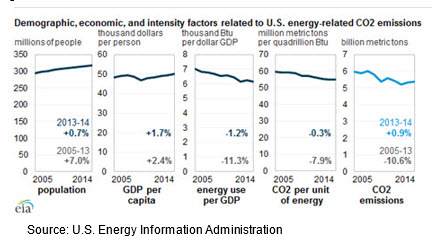WASHINGTON, Dec. 2, 2015 - U.S. carbon dioxide (CO2) energy-related emissions were up 1 percent, or 51 million metric tons (MMmt) in 2014 from the previous year, according to the U.S. Energy Information Administration (EIA). Emissions totaled 5,406 MMmt in 2014, but because of declines in earlier years, were still approximately 10 percent below their 2005 level.
Increases in economic activity generally increase emissions.
In 2014, U.S. gross domestic product (GDP) grew 2.4 percent, while energy use
per GDP declined 1.2 percent and carbon per unit energy declined 0.3 percent.
Transportation fuel prices declined between 2013 and 2014 and lower prices, along with continued economic recovery, led to higher gasoline consumption and higher consumption of other fuels. In 2014, energy-related CO2 emissions in the transportation sector were 24 MMmt higher than the 2013 level.
Commercial sector CO2 emissions rose by 19 MMmt, influenced by weather and economic activity, while residential sector emissions increased by 18 MMmt, primarily influenced by weather in the first quarter of 2014 when heating degree days (a temperature-based measure of expected heating demand) were 10 percent higher than in 2013.
The industrial sector experienced a decline in energy-related CO2 emissions of 11 MMmt in 2014, despite a 13 MMmt increase in natural gas emissions. Natural gas has the lowest carbon intensity of the fossil fuels, so higher use of natural gas meant that more energy was being delivered with fewer overall emissions compared to coal and petroleum liquids, the fuels it likely replaced.
#30
For more news, go to: www.Agri-Pulse.com

